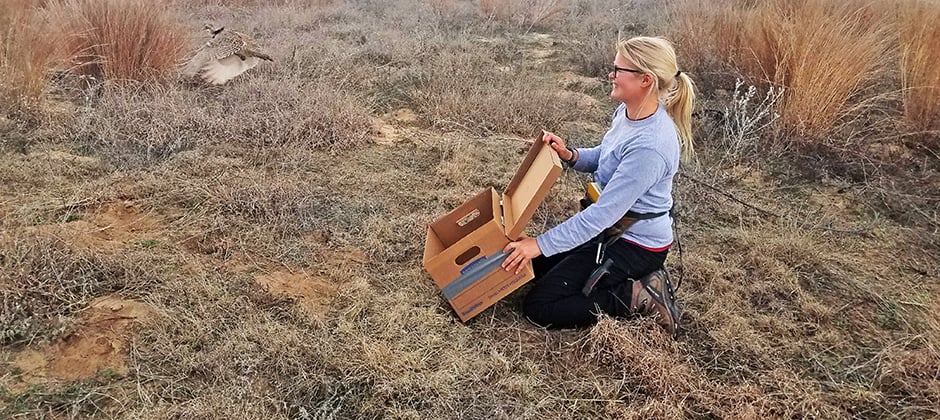Share this article
Lesser prairie-chicken translocation off to promising start
Wildlife managers are seeing initial success after three years of translocating more than 400 lesser prairie-chickens into a sagebrush prairie environment straddling Kansas and Colorado.
“Everybody’s still very excited, still very energized about the project and hoping that we can stabilize these numbers and get this once booming population back to maybe not quite where it was historically, but to a stable point where it was at before,” said Elli Teige, a master’s student at Kansas State University, who displayed the results of her work on a poster at the 2019 Joint Annual Conference of the American Fisheries Society and The Wildlife Society in October.
A healthy lesser prairie-chicken (Tympanuchus pallidicinctus) population used to occupy the Comanche National Grassland in southeastern Colorado and the neighboring Cimarron National Grassland in southwestern Kansas. As recently as the mid-1980s, there were an estimated 86,000 birds in the region. But a prolonged drought and intense winter storms from 2005 to 2013 took a toll, knocking the already declining population on the national grasslands down to as few as 10 birds on the Kansas side and another 20 in Colorado.
As the drought eased and habitat conditions improved, biologists with Colorado Parks and Wildlife; Kansas Department of Wildlife, Parks and Tourism; Kansas State University; and the U.S. Forest Service intervened. They began translocating lesser prairie-chickens from a shortgrass prairie ecoregion in northwestern Kansas to the national grasslands. Between 2017 and 2019, they translocated 411 chickens, nearly evenly split between males and females.
To see how they fared, Teige and her colleagues equipped some of the birds with GPS transmitters and others with VHS tracking devices. They used the transmitters to find nesting sites, then returned to the sites after the hen had left to count how many eggs had hatched. Thirty days after hatching, they flushed surviving broods to count the number of fledged chicks.
They counted 17 known chicks in 2017, 22 in 2018, and 69 in 2019.
“They’ve been doing relatively well,” Teige said.
Researchers plan to return next year.
While intense drought conditions will likely return due to variable weather conditions caused by climate change, Teige said, management actions, such as reducing intensity of cattle grazing or rotating grazing more often, may be able to mitigate some of the negative effects of drought.
Header Image: Researcher Ellie Teige releases a lesser prairie-chicken near Elkhart, Kansas, on the Cimarron National Grasslands. ©Nicholas Parker








